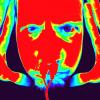Hello all, so after researching like a law student these last couple months, I think I have an idea on how it might be possible to repair a CNS glial scar. There's many variables naturally, but I'm curious if this approach seems right to everyone here. If so, it'd be exciting to see what help it could be for someone with TBI or MS. I posted the following to the Narcolepsy Network forums:
Now, it's known that after a traumatic brain injury (TBI) or a stroke, reactive gliosis by glial cells in the brain cause a glial scar to form. Evidence of this happening is detailed in the following studies:https://www.ncbi.nlm...les/PMC2717206/ (Localized Loss of Hypocretin (Orexin) Cells in Narcolepsy Without Cataplexy)https://www.uptodate...lts/abstract/57 (Pattern of hypocretin (orexin) soma and axon loss, and gliosis, in human narcolepsy)Herein lies the hard part and the reason Narcolepsy is so hard to treat and solve. When a glial scar is formed in the Central Nervous System (CNS) or spinal cord, it forms a lining that resists axon growth. Therefore, without intervention, the scar would be permanent, and no amount of neurogenesis inducing substances would be able to penetrate the glial scar. However, research in this field has accelerated highly in recent years, and there is hope.The brain uses different growth factors such as BDNF, NGF, GDNF, NT3, and CNTF to extend dendritic branching and axons. The goal is to use these to grow new orexin neurons over the scar tissue in the hypothalamus, and/or convert the glial cells into functioning neurons. The glial scar has a number of ways that it inhibits growth. It's a little too complicated to go into too much detail, but I'll include a few main ones as well as links to a number of studies at the bottom.1. Modification of sulphated proteoglycansWhat are these you may ask? I'm going to quote extensively from the study "Regeneration Beyond The Glial Scar" (http://www.nature.co...ll/nrn1326.html). To start:QuoteIn addition to growth-promoting molecules46, 47, astrocytes produce a class of molecules known as proteoglycans48, 49. These ECM molecules consist of a protein core linked by four sugar moieties to a sulphated GLYCOSAMINOGLYCAN (GAG) chain that contains repeating disaccharide units. Astrocytes produce four classes of proteoglycan; heparan sulphate proteoglycan (HSPG), dermatan sulphate proteoglycan (DSPG), keratan sulphate proteoglycan (KSPG) and chondroitin sulphate proteoglycan (CSPG)50. The CSPGs form a relatively large family, which includes aggrecan, brevican, neurocan, NG2, phosphacan (sometimes classed as a KSPG) and versican, all of which have chondroitin sulphate side chains. They differ in the protein core, as well as the number, length and pattern of sulphation of the side chains51, 52, 53. Expression of these CSPGs increases in the glial scar in the brain and spinal cord of mature animals54, 55, 56.Proteoglycans have been implicated as barriers to CNS axon extension in the developing roof plate of the spinal cord57, 58, in the midline of the rhombencephalon and mesencephalon59, 60, at the dorsal root entry zone (DREZ)61, in retinal pattern development62, 63, and at the optic chiasm and distal optic tract64, 65. Extensive work has demonstrated that CSPGs are extremely inhibitory to axon outgrowth in culture. Neurites growing on alternating stripes of laminin and laminin/aggrecan had robust outgrowth on laminin, but at the sharp interface between the two surfaces, growth cones rapidly turned away (unlike their stalled behaviour in a gradient, see above). The inhibitory nature of the proteoglycan-containing lanes can repel embryonic as well as adult axons, and the effect can last for more than a week in vitro. The turning behaviour is not usually mediated by collapse of the entire growth cone, but rather by selective retraction of FILOPODIA in contact with CSPG and enhanced motility of those on laminin66, 67. CSPGs are potent inhibitors of a wide variety of other growth-promoting molecules, including fibronectin and L1 (Refs 68,69).This is one of the most important steps to overcome. In the same study, it has been shown that, and I quote, "chondroitinase — an enzyme extracted from the bacterium Proteus vulgaris that selectively removes a large portion of the CSPG GAG side chain and renders CSPGs less inhibitory". Now, unfortunately I don't know where to get chondroitinase, if it passes the BBB, or how to guide it to the hypothalamus. However, after scouring pubmed for hours to find a replacement, I found good ol' Turmeric helps here:QuoteCurcumin improves neural function after spinal cord injury by the joint inhibition of the intracellular and extracellular components of glial scarResultsWe found that cur inhibited the expression of proinflammatory cytokines, such as TNF-α, IL-1β, and NF-κb; reduced the expression of the intracellular components glial fibrillary acidic protein through anti-inflammation; and suppressed the reactive gliosis. Also, cur inhibited the generation of TGF-β1, TGF-β2, and SOX-9; decreased the deposition of chondroitin sulfate proteoglycan by inhibiting the transforming growth factors and transcription factor; and improved the microenvironment for nerve growth. Through the joint inhibition of the intracellular and extracellular components of glial scar, cur significantly reduced glial scar volume and improved the Basso, Beattie, and Bresnahan locomotor rating and axon growth.Turmeric also has HDAC inhibiting properties, making the brain more malleable to change and encouraging it to return to homeostasis. I won't go too deep into HDAC but it seems to help.2. Blocking the effects of myelinAgain, what's this and what would it do? Here's another citation from the same article:QuoteIn addition to enhancing regeneration by removing the inhibitory effects of CSPGs, extensive work has shown that blocking Nogo, a myelin-associated inhibitor of regeneration, improves regeneration105. Antibodies directed against the Nogo receptor administered into spinal cord lesion sites106 or even systemically107 seem to enhance regeneration, although recent work108 has disputed whether this is truly enhanced regeneration or merely local sprouting. Indeed, it is now being suggested that most of the functional recovery that is seen when inhibitors of myelin are used occurs as a result of remodelling of local circuits, such that functional recovery is mediated along uninjured long axons108. This proposal, in conjunction with work from our laboratory demonstrating rapid axon regrowth from adult neurons in the presence of degenerating white matter83, 84, as well as the differences between growth cone collapse and dystrophy, indicates that myelin might not be acting fundamentally to inhibit long-distance regeneration. In fact, it has even been suggested that myelin might facilitate axon growth under certain conditions109.So how do we get around this issue? Here, we turn to Longecity and the amazing research of some of users there (http://www.longecity...th/#entry737252). To cite only 2 studies, Ginseng and Horny Goat Weed (Icariin) are potent in this regard:QuoteRESULTS:We determined 1) GTS (Ginsenoides) (5-80 mg/kg) treatment after a TBI improved the recovery of neurological functions, including learning and memory, and reduced cell loss in the hippocampal area. The effects of GTS at 20, 40, 60, and 80 mg/kg were better than the effects of GTS at 5 and 10 mg/kg. 2) GTS treatment (20 mg/kg) after a TBI increased the expression of NGF, GDNF and NCAM, inhibited the expression of Nogo-A, Nogo-B, TN-C, and increased the number of BrdU/nestin positive NSCs in the hippocampal formation.QuoteIcariin, the major active component of Chinese medicinal herb epimedium brevicornum maxim, is used widely in traditional Chinese medicine for the treatment of neurological diseases. However, the effects of icariin on myelin inhibitory factors are as yet unclear. In the present study, administration of icariin at 20 mg/kg showed a marked reduction in neurological deficit of middle cerebral artery occlusion rats. Icariin exhibited better inhibitory effects on myelin inhibitory factors: Nogo-A, myelin-associated glycoprotein and oligodendrocyte myelin glycoprotein in ischemia regions of middle cerebral artery occlusion rats compared with monosialotetrahexosylganglioside. These results indicate that icariin exhibits potent inhibitory effects on expression of myelin inhibitors after middle cerebral artery occlusion-induced focal cerebral ischemia in vivo. This effect may be mediated, at least in part, by the inhibition of both Nogo-A, myelin-associated glycoprotein and oligodendrocyte myelin glycoprotein activation, followed by the enhancement of axonal sprouting and regeneration, resulting in neurological functional...Seems Nogo is among the easier things to inhibit, thankfully.3. Enhancing the intrinsic growth machinery.This is pretty straightforward, we want the best environment for these new axons to differentiate and turn into full neurons:QuoteRemoval of extrinsic inhibitory cues from the glial scar with treatments such as chondroitinase might aid regeneration, but this might not be sufficient for long-range re-growth. Neurotrophin 3 (NT3) or nerve growth factor (NGF), when delivered directly to transected neurons in the dorsal columns of animals treated with peripheral nerve graft transplants, enhances growth into the graft, out the opposite end and beyond the glial scar into host tissue110, 111. Exogenous NGF administration also induces sprouting into the lesion of crushed dorsal columns112. Intrathecal or adenoviral application of NT3 or NGF to the injured DREZ induces DRG neurons to cross the peripheral nervous system/CNS barrier and penetrate some distance into the spinal cord113, 114, 115, 116, 117, where the regenerating fibres restore nocioceptive function. So, evidence from the injured spinal cord and DREZ indicates that regenerating axons can overcome proteoglycan barriers after neurotrophin stimulation, perhaps through induction of growth enhancing genes, offering an additional therapeutic strategy.As for Nerve Growth Factor, there's myriad things that stimulate this, so whatever you decide to take, make sure you enhance it with Acetyl L-Carnitine, which is supposed to enhance NGF by x100 according to a study I've recently misplaced. As for Neurotrophin 3, again, we have some amazing phytoconstituents to help. Another Longecity thread (http://www.longecity...s-into-neurons/) helped me find studies for 2 substances in particular, Chinese Skullcap and Ziziphus Jujube:QuoteBaicalin promotes neuronal differentiation of neural stem/progenitor cells through modulating p-stat3 and bHLH family protein expression.Signal transducer and activator of transcription 3 (stat3) and basic helix-loop-helix (bHLH) gene family are important cellular signal molecules for the regulation of cell fate decision and neuronal differentiation of neural stem/progenitor cells (NPCs). In the present study, we investigated the effects of baicalin, a flavonoid compound isolated from Scutellaria baicalensis G, on regulating phosphorylation of stat3 and expression of bHLH family proteins and promoting neuronal differentiation of NPCs. Embryonic NPCs from the cortex of E15-16 rats were treated with baicalin (2, 20 μM) for 2h and 7 days. Neuronal and glial differentiations were identified with mature neuronal marker microtubule associated protein (MAP-2) and glial marker Glial fibrillary acidic protein (GFAP) immunostaining fluorescent microscopy respectively. Phosphorylation of stat3 (p-stat3) and expressions of bHLH family genes including Mash1, Hes1 and NeuroD1 were detected with immunofluorescent microscopy and Western blot analysis. The results revealed that baicalin treatment increased the percentages of MAP-2 positive staining cells and decreased GFAP staining cells. Meanwhile, baicalin treatment down-regulated the expression of p-stat3 and Hes1, but up-regulated the expressions of NeuroD1 and Mash1. Those results indicate that baicalin can promote the neural differentiation but inhibit glial formation and its neurogenesis-promoting effects are associated with the modulations of stat3 and bHLH genes in neural stem/progenitor cells.QuoteThe treatment with jujube water extract stimulated the expressions of neurotrophic factors in a dose-dependent manner, with the highest induction of ~100% for NGF, 100% for brain-derived neurotrophic factor (BDNF), 100% for glial cell line-derived neurotrophic factor (GDNF) and 50% for neurotrophin 3 (NT3). These results supported the neurotrophic role of jujube on the brain.Now, I have no idea how long it would take, under ideal circumstances, for the brain to regrow orexin neurons after disinhibiting growth and inducing axon growth in this manner. Any help understanding the process behind regrowing the hypothalamus and guiding growth to this section of the brain would be much appreciated. In the meantime, I leave everyone with some studies:https://www.ncbi.nlm...les/PMC2693386/ (Glial inhibition of CNS axon regeneration)https://www.ncbi.nlm...les/PMC3140701/ (Enhancing Central Nervous System Repair-The Challenges)http://www.nature.co...ll/nrn1326.html (Regeneration Beyond The Glial Scar)Also, these longecity threads helped me find a few relevant studies as well as substances to help neurogenesis:
















































